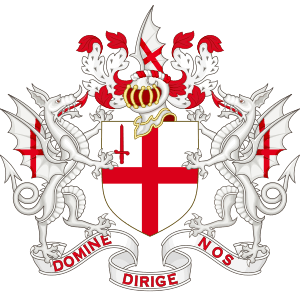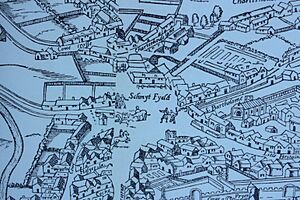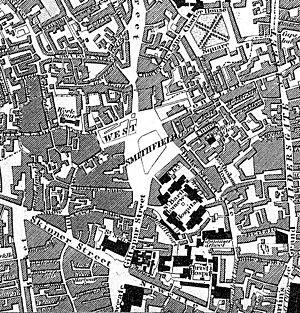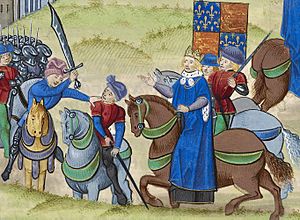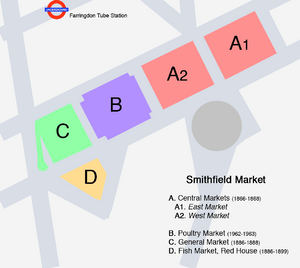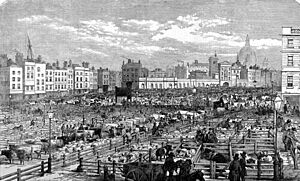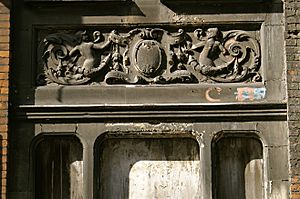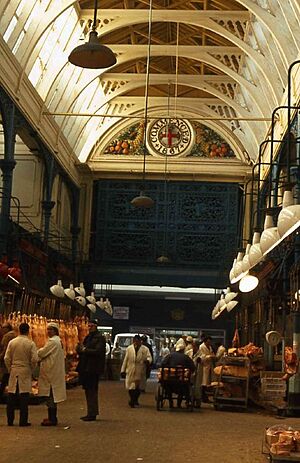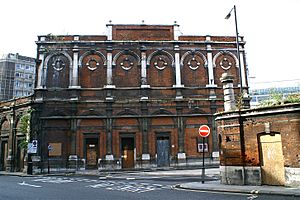Smithfield, London facts for kids
Quick facts for kids Smithfield |
|
|---|---|
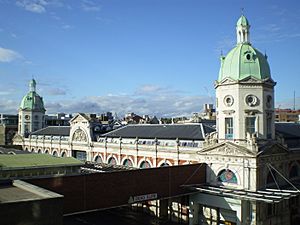 Smithfield Meat Market |
|
| Sui generis | |
| Administrative area | Greater London |
| Region | |
| Country | England |
| Sovereign state | United Kingdom |
| Post town | LONDON |
| Postcode district | EC1 |
| Dialling code | 020 |
| Police | City of London |
| Fire | London |
| Ambulance | London |
| EU Parliament | London |
| UK Parliament |
|
| London Assembly | |
Smithfield, also known as West Smithfield, is an area in Central London, England. It is part of the City of London, which is the historic heart of London.
Smithfield is home to important places like St Bartholomew's Hospital and old guild halls, such as those for butchers and haberdashers. The area is most famous for its meat market, which has been open for over 1,000 years! It's London's only remaining wholesale market. For many centuries, from the 1100s to the 1800s, Smithfield also hosted the Bartholomew Fair, a huge annual festival.
The main street in Smithfield is called West Smithfield. You can also find St Bartholomew-the-Great here, the City's oldest church building, built in 1123. Most other churches in the City were destroyed in the Great Fire of 1666.
Smithfield has been a place where many important historical events happened. Famous figures like the Scottish knight Sir William Wallace and Wat Tyler, who led the Peasants' Revolt, faced their end here.
The current Smithfield Market building, a Grade II listed structure, was designed by architect Sir Horace Jones in the 1800s. It's a key part of the area's look. Some parts of the market were not used much in the late 1900s. In 2012, there was a plan to update Smithfield while keeping its historical feel, which many people supported.
What is the Smithfield Area Like?
In the Middle Ages, Smithfield was a large, open grassy area called Smooth Field. It was outside the old London Wall and stretched to the River Fleet. Because it was easy to reach and had good water, Smithfield became London's main livestock market. It stayed that way for almost 1,000 years!
Many street names in the area still remind us of the animal trade. For example, "Cow Cross Street" and "Cock Lane" are still there. Other names like "Chick Lane" and "Duck Lane" have disappeared as the area was rebuilt in the Victorian era.
Smithfield's Religious History
In 1123, King Henry I allowed Prior Rahere to build St Bartholomew's Priory near Aldersgate. This was a thank you for Rahere being nursed back to health. The Priory was allowed to use the land around it, building a main gate that opened onto Smithfield.
The Priory was given the right to hold weekly fairs. These first took place in its outer courtyard. An even bigger yearly event, the Bartholomew Fair, started in 1133. It became one of London's most important summer festivals, opening every year on August 24th. This four-day festival was a place to trade cloth and other goods. It was also a fun event that attracted people from all parts of English society.
However, by 1855, the City authorities closed Bartholomew Fair. They felt it had become too wild and caused too much public disorder.
In 1348, Walter de Manny rented land near Smithfield for a graveyard for victims of the Black Death. A chapel was built there. Later, in 1371, this land became the site of the Charterhouse, which was originally a Carthusian monastery.
Nearby, the Knights Hospitaller built a Commandery (a type of headquarters) dedicated to St John in the mid-1100s. They received special rights from King Richard I in 1194. Later, Augustinian nuns built the Priory of St Mary north of the Knights of St John's property.
By the end of the 1300s, City traders felt these religious houses were taking up public land. The Charterhouse buildings were even damaged by vandals. By 1405, a strong wall was built to protect the property.
During the English Reformation, these religious houses were closed down, and their lands were divided. Parts of the Priory Church of St John and St John's Gate still remain. Some monks from Charterhouse, including John Houghton, were put to death in the 1530s for not agreeing with King Henry VIII's religious changes.
After the monks were removed, Charterhouse became a private home. In 1611, Thomas Sutton turned it into a charity. It became the basis for Charterhouse School and almshouses. The school later moved to Godalming in 1872. Today, parts of the site are used by Barts and The London School of Medicine and Dentistry.
From the start, St Bartholomew's Priory helped the sick. After the Reformation, King Henry VIII refounded it in 1546 as "the House of the Poore in West Smithfield." It became St Bartholomew's Hospital, often called Barts. The King Henry VIII Gate, built in 1702, is still the hospital's main entrance.
The Priory's main church, St Bartholomew-the-Great, became an Anglican parish church after the monasteries were closed. Its boundaries were limited to the old priory site. Another church, St Bartholomew-the-Less, was also created for the hospital.
Smithfield and its Market are mostly in the parish of St Sepulchre. This parish was founded in 1137 by Prior Rahere, who also founded St Barts. St Sepulchre's Tower has the twelve "bells of Old Bailey," mentioned in the nursery rhyme "Oranges and Lemons". In the past, the Great Bell would ring to announce when a prisoner was put to death at Newgate.
Smithfield's Civil History
Smithfield was a large open space close to the City, making it a popular spot for public gatherings. In 1374, Edward III held a seven-day tournament here. Perhaps the most famous medieval tournament at Smithfield was in 1390, ordered by Richard II. Sixty knights and sixty noble ladies took part in a grand jousting event. Geoffrey Chaucer helped prepare for this tournament.
For centuries, Smithfield was a main site for putting people to death in London, especially those seen as heretics or dissidents. The Scottish nobleman Sir William Wallace was executed here in 1305. The market was also where the Peasants' Revolt leader, Wat Tyler, was killed by Sir William Walworth, the Lord Mayor of London, on June 15, 1381.
During the reigns of different monarchs, many religious dissenters were put to death here. About fifty Protestants, known as the Marian martyrs, were executed at Smithfield during the reign of Mary I.
On November 17, 1558, several Protestants were saved. A royal messenger announced that Queen Mary had died just before they were to be put to death. Under English law, death warrants needed the monarch's signature. Since Queen Elizabeth I did not approve the executions, the Protestants were freed. In the 1500s, Smithfield was also where swindlers and coin forgers were put to death.
By the 1700s, "Tyburn Tree" became the main place for public executions in London. After 1785, executions moved again, this time to the gates of Newgate prison, south of Smithfield.
Smithfield was mostly unharmed by the Great Fire of London in 1666. The fire stopped near the Fortune of War Tavern, where the Golden Boy of Pye Corner statue is. In the late 1600s, some Smithfield residents moved to North America and founded the town of Smithfield, Rhode Island.
Smithfield Today
Since the late 1990s, Smithfield and nearby Farringdon have become popular for young professionals. They enjoy the area's bars, restaurants, and nightclubs.
Clubs like Fabric helped make the area known for its lively night life. People from nearby areas and even outside London come here on weekends.
Smithfield also hosts sporting events. Until 2002, the annual Miglia Quadrato Car Rally started here at midnight. Since 2007, Smithfield has been the site of the Smithfield Nocturne, an annual road bicycle racing event.
Number 1, West Smithfield is the head office of the Churches Conservation Trust.
Smithfield Market
Market Origins
Meat has been traded at Smithfield Market for over 800 years, making it one of London's oldest markets. A livestock market was here as early as the 900s.
In 1174, a writer named William Fitzstephen described the site: "a smooth field where every Friday there is a celebrated rendezvous of fine horses to be traded, and in another quarter are placed vendibles of the peasant, swine with their deep flanks, and cows and oxen of immense bulk." Rules and costs were carefully set. For example, for an ox, a cow, or a dozen sheep, you would pay 1 penny.
The livestock market grew over centuries to meet the needs of London's growing population. By 1710, the market was fenced to keep the animals inside. Daniel Defoe wrote in 1726 that it was "without question, the greatest in the world."
Between 1740 and 1750, about 74,000 cattle and 570,000 sheep were sold at Smithfield each year. By the mid-1800s, 220,000 cattle and 1,500,000 sheep were brought into a small area of five acres in the middle of London. The large number of animals being driven through the city caused major concerns.
The Great North Road traditionally began at Smithfield Market. Road distances were measured from Hicks Hall, a short distance up St John Street. This starting point was used even after the hall was torn down in 1778. The road went north to Edinburgh. In 1829, the General Post Office became the new starting point for mileages.
Campaigns Against the Cattle Market
In the Victorian era, people started to campaign for the livestock market to be moved outside the City. This was because of very poor hygiene and the harsh treatment of animals. Conditions in the market in the early 1800s were seen as a big threat to public health:
"Of all the horrid abominations with which London has been cursed, there is not one that can come up to that disgusting place, West Smithfield Market, for cruelty, filth, effluvia, pestilence, impiety, horrid language, danger, disgusting and shuddering sights, and every obnoxious item that can be imagined; and this abomination is suffered to continue year after year, from generation to generation, in the very heart of the most Christian and most polished city in the world."
In 1843, the Farmer's Magazine published a petition from bankers, salesmen, butchers, and City residents. They argued against expanding the meat market, noting that livestock markets had been banned in other parts of London since the Middle Ages.
Charles Dickens criticized having a livestock market in the heart of London in his 1851 essay A Monument of French Folly. He compared it to the French market at Poissy, which was outside Paris.
An Act of Parliament was passed in 1852. This law said that a new cattle market should be built at Copenhagen Fields, Islington. The Metropolitan Cattle Market opened in 1855. This left West Smithfield as empty land for about ten years while the new market was being built.
Victorian Smithfield: Meat and Poultry Market
The current Smithfield meat market on Charterhouse Street was created by a law in 1860. It's a large market with permanent buildings, designed by architect Sir Horace Jones. He also designed Billingsgate and Leadenhall markets. Work on the Central Market began in 1866 and finished in November 1868.
The main parts of the market are called East and West Market. They are separated by the Grand Avenue, a wide road with an arched roof. At the ends of the arcade, four large statues represent London, Edinburgh, Liverpool, and Dublin. They show bronze dragons with the City's coat of arms. At the corners of the market, there are four octagon-shaped towers with domes and carved stone griffins.
As the market was built, a railway tunnel was constructed underground. This allowed animal carcasses to be brought to a cold storage area and then lifted directly to the meat market. These railway lines closed in the 1960s and are now used as a car park. Today, most meat arrives at the market by road.
The first expansion of Smithfield's meat market happened between 1873 and 1876. This was when the Poultry Market was built west of the Central Market. A round building was added in the middle of the old Market Field (now West Smithfield). This area included gardens, a fountain, and a ramp down to the station below the market. More buildings were added later. The General Market, built between 1879 and 1883, was meant to replace the old Farringdon Market for selling fruit and vegetables.
Another block, called the Annexe Market or Triangular Block, was built between 1886 and 1899. It had two separate parts: the Fish Market and the Red House. The Fish Market was finished in 1888. The Red House, with its impressive red brick and stone front, was built between 1898 and 1899. It was one of the first cold storage facilities built outside the London Docklands and served Smithfield Market until the mid-1970s.
20th Century Events
During Second World War, a large underground cold storage area at Smithfield was used for secret experiments. Dr Max Perutz studied pykrete, a mix of ice and woodpulp, which was thought to be stronger than steel. These experiments were part of a project to build floating airstrips in the Atlantic for planes. Perutz and his team did their work in a refrigerated meat locker in a butcher's basement at Smithfield Market. The project was stopped when longer-range aircraft were developed.
Towards the end of the Second World War, a V-2 rocket hit the north side of Charterhouse Street in 1945. The explosion caused huge damage to the market buildings and the railway tunnel below. More than 110 people died.
On January 23, 1958, a fire started in the basement of the Union Cold Storage Co at the Smithfield Poultry Market. The fire spread through the many basements under the market and burned for three days. Over 1,700 firefighters with 389 fire engines were needed to control the blaze. Two firefighters died, and 50 were injured. The market was mostly destroyed, and parts that weren't directly burned collapsed. After this fire, the London Fire Brigade started using breathing apparatus.
A red plaque was put up at the market on the 60th anniversary of the fire to remember the two firefighters who died. A new building was designed by Sir Thomas Bennett in 1962–63. It has a concrete frame and dark blue brick outside. The main hall has a huge concrete dome, which was believed to be the largest concrete shell structure built in Europe at that time.
Smithfield Market Today
Smithfield is the City of London's only major wholesale market that has not moved out of central London. Other markets like Covent Garden, Spitalfields, and Billingsgate have all relocated. Smithfield Market continues to supply butchers, shops, and restaurants in the city with fresh meat. Its main trading hours are from 4:00 AM to 12:00 noon on weekdays. Instead of moving, Smithfield Market is updating its current site. Its large Victorian buildings now have access points for lorries to load and unload.
The buildings stand above a network of tunnels. In the past, live animals were brought to the market and killed on site. The old railway tunnels are now used for storage, parking, and as basements. A cobbled ramp spirals down around West Smithfield's public garden, giving access to part of this underground area. Some buildings on Charterhouse Street also have basement access to the tunnels.
Some of the old meat market buildings have changed their use. For example, the former Central Cold Store on Charterhouse Street is now a cogeneration power station run by Citigen. The Metropolitan Cold Stores building was turned into the nightclub Fabric in 1999.
Smithfield is centered around the market. It is surrounded by many old buildings on three sides and a public open space (or Rotunda Garden) at West Smithfield. Below this garden is a public car park. On the south side is St Bartholomew's Hospital (known as Barts). On the east side is the Priory Church of St Bartholomew the Great. The Church of St Bartholomew the Less is next to the King Henry VIII Gate, which is the hospital's main entrance.
The north and south sides of the square are now closed to through traffic. This is part of the City's security measures, known as the Ring of steel. Security for the market is handled by its own market police.
Future Plans for Smithfield Market
In early 2019, there was a proposal for Billingsgate Fish Market, New Spitalfields Market, and Smithfield Market to all move to a new combined site in Dagenham Dock. A formal plan was submitted in June 2020 and received initial approval in March 2021.
Building Plans and Preservation
Since 2005, the General Market (built 1883) and the nearby Fish Market and Red House buildings (built 1898) have been at risk of being torn down. The City of London Corporation, who owns the property, has been asking the public for ideas on how to reuse these old buildings and improve the area. One plan by a developer wanted to demolish the historic site and build a seven-story office block.
Several groups, like English Heritage and Save Britain's Heritage, started campaigns to raise awareness about saving London's Victorian heritage. The Red House Cold Store building was given Grade II listed building protection in 2005. This was because new historical evidence showed it was "the earliest existing example of a purpose-built powered cold store."
Even though the market is still open, its future is uncertain. In 2007, a major public inquiry was started by Planning Minister Ruth Kelly. The inquiry about tearing down and redeveloping the General Market Building took place from November 2007 to January 2008. In August 2008, Communities Secretary Hazel Blears said that permission for the General Market's redevelopment was refused. She stated that the buildings "made a significant contribution" to the character of Farringdon and the surrounding area.
On October 12, 2012, the Henderson Group presented a £160 million plan to redevelop the western side of the Central Market. Henderson suggested that the fish market, General Market, and Red House buildings be torn down to make way for restaurants, shops, and offices. They planned to keep and restore most of the market building's original outer walls and create a new public square in the General Market area. Marcus Binney from the group Save Britain's Heritage called this plan "the worst damage to a Victorian landmark in the last 30 years."
Some buildings on Lindsey Street opposite the East Market were torn down in 2010. This was to allow the construction of the new Elizabeth line station at Farringdon.
In March 2015, the Museum of London announced plans to move from its Barbican site into the General Market Building. The current museum site closed in December 2022 to prepare for this move.
Images for kids
-
The Port of London Authority building
See also
 In Spanish: Smithfield (Londres) para niños
In Spanish: Smithfield (Londres) para niños
- Farringdon Without Ward
- List of markets in London
- List of people executed in Smithfield
- Wife selling appeared in satire as occurring at Smithfield Market, during the 18th century.



